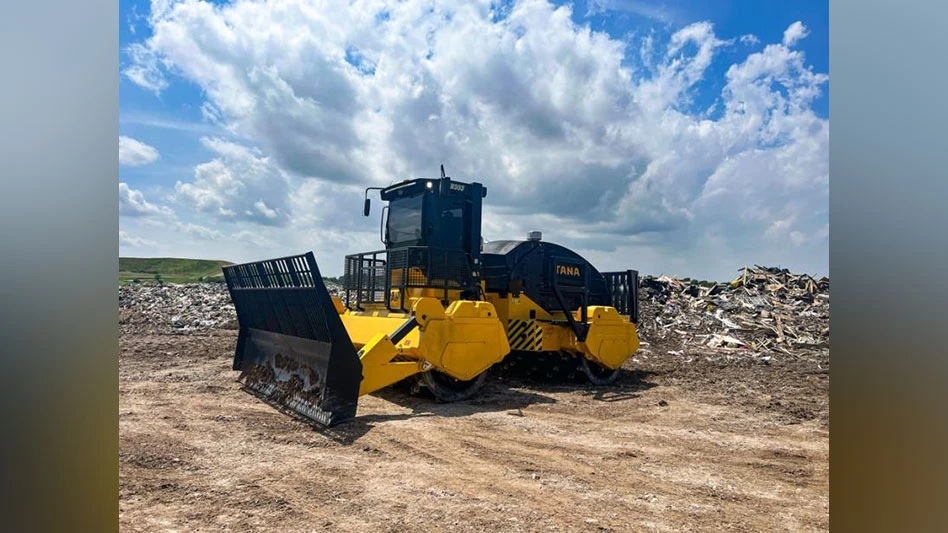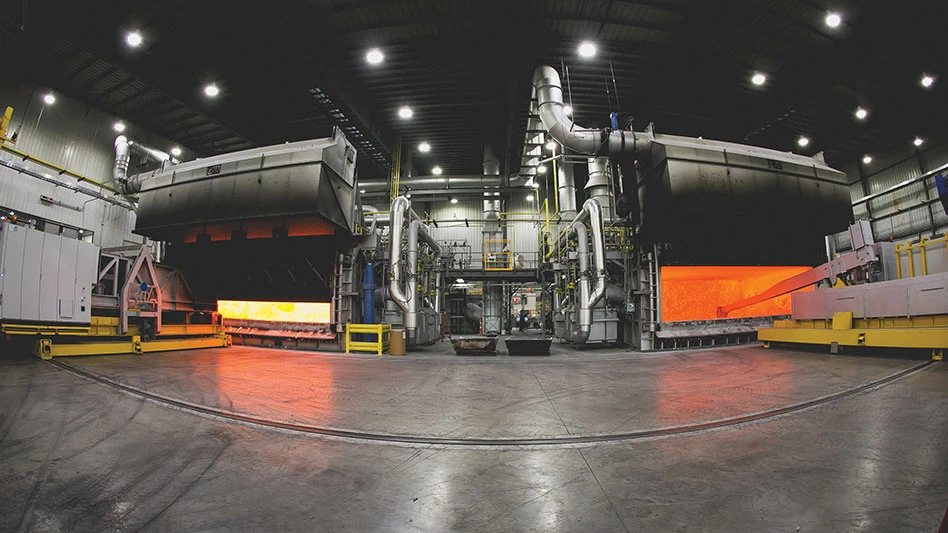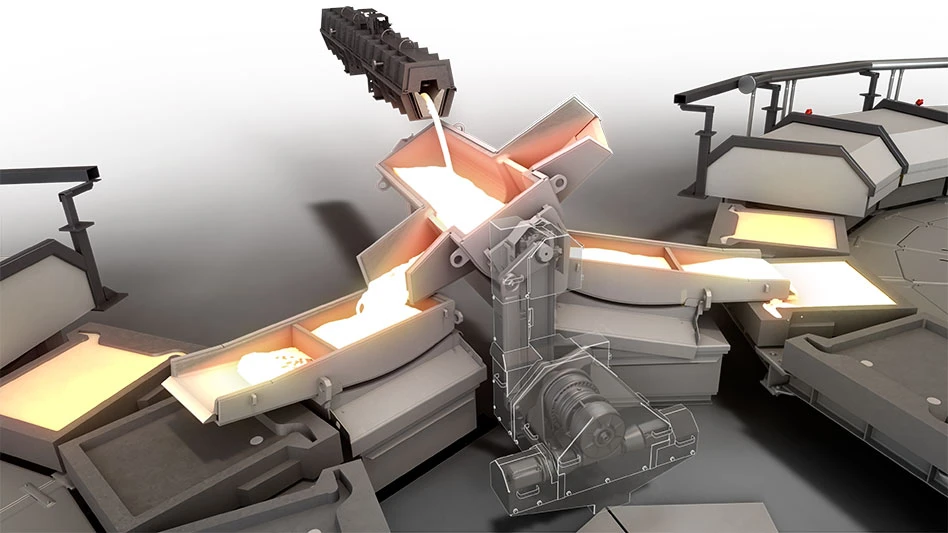Automobile Shredders
Hammermills – often called automobile shredders but used to shred other materials as well – break up material using huge hammers attached to a rotor. Hammermills range in diameter from laboratory size – as small as nine inches – up to 120 inches in diameter. Capacities generally range from 5 horsepower to 6,000 horsepower.
These multi-purpose, heavy-duty machines are suitable for processing materials such as ferrous and nonferrous turnings, aluminum cans, aluminum scrap, ferrous scrap such as sheet iron, automobiles and white goods, along with nonmetallic material such as chemicals, coal, limestone, firebrick, asphalt and shingles. They are typically used in scrap yards, resource recovery plants, municipal solid waste facilities, refineries and smelters.
The hammermill breaks up products, separating ferrous from nonferrous material, which can be further separated using downstream processing equipment such as magnets, cleaning systems and dense media systems.
How does it work? The hammermill is generally four-armed, with heavy-duty swing hammers that can be reversed for wear. The units are generally furnished with outboard flywheels for pulling them through any surge load periods.
These machines can be diesel driven or electrically powered, and can have alternating current (AC) motors or direct current (DC) motors. The larger units have circulating oil for the bearings. Hammermills are generally opened hydraulically for quick and easy access to the interior of the machine without disturbing the feed hopper during maintenance and inspection.
For scrap applications, larger machines generally use manganese or T-1 liners. And in the larger machines, reject doors in the back upper housing are furnished for ejecting unshreddable items.
Hammermills (without motor or associated systems) generally range in price from $7,500 to $1.25 million depending upon the capacities, the material to be processed and the product size required.
By Ed Kramer, sales engineer, American Pulverizer, St. Louis.
Non-Automotive Uses
Hammermills are often associated with shredding automobiles and other heavy scrap. But smaller sized hammermills, which also reduce by impact rather than by sharpness, can be used for shredding aluminum sheet, cast and extrusions; steel shredding clips; white goods; small appliances; automobile parts; wooden pallets; batteries of all kinds; and other materials.
While it’s true that hammermills are noisier than shear type shredders and they create more dust, this is more than offset by the higher capacity, lower maintenance and reduced down time. Many hammermills have been in service for fifty years and are still going.
There are also double rotor hammermills which can take the material discharged from the primary hammermill and grind it to a smaller size.
Shredder Systems Overview
Shredder systems today are basically divided into four different sections: the shredder drive (motor), the infeed conveyor, the shredder and feed device and downstream cleaning equipment.
Shredder Drive
Two basic types of alternating current (AC) motors have been used to drive shredders for the past three decades – a squirrel cage design and a wound rotor type. Both types do an effective job of shredding, but the wound rotor motor tends to have a longer life span and a lower energy demand. The wound rotor motor is more expensive initially, but adds value through time due to the longer life and the lower power costs.
In the 1990s, direct current (DC) motors have come into use for shredders. The DC motor offers processors the ability to regulate rotations per minute (RPMs), which is an advantage, but many in the industry feel that the control package still needs to be refined. It has now been proven that running shredder motors at lower RPMs creates numerous advantages from the older higher RPM motors. The lower RPMs create more torque, which allows for more effective shredding, yielding better production, longer life for parts and lower overall shredding costs.
Infeed Conveyor
The typical infeed conveyor for a shredder is a heavy-duty steel track conveyor. The conveyor is generally built using wide flange beams, I-beams, rectangular tubing, heavy channel, heavy angle and ½" plate skirting. There is a horizontal loading section of about 15 feet to 20 feet and a horizontal section at the head of the conveyor approximately 10 feet. The typical drives are hydraulic, for variable speed, but electric drives can also be used.
SHREDDER AND FEED DEVICE
The typical automobile shredder is designed to process a wide variety of materials, including whole or flattened cars (without gas tanks), miscellaneous loose appliances, and a wide range of No. 2 scrap with a maximum thickness of ¼ inch. The old standard wall thickness of shredders was two inches, but today almost all shredders are made of four-inch steel. In addition, virtually all shredders made today are dual discharge. Having a dual discharge increases tonnage output and lowers operating costs. The heavy shredders (four-inch thick walls) routinely run light No. 1 material (up to ½ inch or heavier cast iron.)
Some feeding devices are designed with a 35-degree feed angle. This is steep enough for all types of scrap to slide down easily. If it is steeper, there are additional costs since the infeed conveyor must be longer. Grouser bars run the length of the chute and a replaceable section is provided underneath the feedrolls. The double feedroll is often the preferred way to feed the shredder. The typical double feedroll is 36 inches in diameter, driven by hydraulic drives with variable speed controllable by the operator or by automatic mode.
Downstream Cleaning System
The undermill vibrator carries the scrap from the shredder to the first transfer conveyor. Rotary electric drives for the undermill vibrator have proven to be beneficial because they are generally low-maintenance and are sturdy enough to handle explosions. Generally, most conveyors have a flat design, allowing for a thinner depth burden, which makes it easier to clean the product.
The typical system has from one to three drum magnets – the wider, the better – for separating ferrous material from nonferrous. These drum magnets can be a radial design or an axial design. Usually a picking vibrator/oscillator or conveyor follows the magnets, allowing for hand picking. This will feed a radial stacker, which can stockpile material or feed it directly into trucks or railcars.
Generally the remaining material then passes through some type of ferrous recovery magnet (crossbelt or magnetic head pulley), and a screening device such as a trommel to capture the fines (typically 3/8 inches and under). Eddy current separators are then usually used to separate the nonferrous metals from the stream.
Shredder Sizes
Here are some typical sizes for scrap shredders with nominal capacity output at 70 pounds per cubic foot (all dual discharge). All tons are gross per hour.
1500 horsepower, 720-RPM, 60/80 dual discharge, output tons per hour: 25 to 30 tons.
2500 horsepower, 600-RPM, 80/104 dual discharge, output tons per hour: 60 to 70 tons.
4000 horsepower, 500-RPM, 98/104 dual discharge, output tons per hour: 120 to 140 tons.
6000 horsepower, 450-RPM, 62/108 dual discharge, output tons per hour: 180 to 250 tons.
By Mark Mullins, sales manager for Texas Shredder Parts Inc., San Antonio, Texas.
Super Sized Shredders
The more than 30-year evolution of the scrap shredder has taken another turn. Scrap shredders have gone from being really large to significantly smaller, and now they are back to being really large.
In the 1950s and 1960s, there were a few shredders around with as much as 10,000-horsepower motors attached. These were basically huge rock crushers with "no control" feeding devices where the scrap fell into the maw of the machine, unimpeded by the feed-roll apparatus that the modern machines use to meter scrap into the shredder. These machines were in the downtown areas of large cities and needed to shred at lease 1,000 tons a day.
Beginning in the mid 1960s, Newell’s 2,000-horsepower top discharge shredders could be built with all of the necessary downstream separation equipment and installed for about 50 percent of the cost of the monster shredders of the 10,000 horsepower variety.
From these early 74-inch and 80-inch shredders of top and bottom discharge design came the 96-inch and 98-inch shredders with 4,000 and 5,000 horsepower motors. Diameter and horsepower went up. But the shredders were fundamentally the same, just a little bigger with high production and higher cost. All of the shredders up to 1980 were primarily automobile shredders.
The major challenge these shredders faced was that they were not able to handle much unshreddable material without suffering major damage and downtime. Even the use of heavier plate in the mills and larger castings was not completely cost effective. By the late 1980s and 1990s a new type of shredder was needed.
The generic term "super sized shredder" is being applied to a series of machines with a hammer swing of approximately 120 inches in diameter, with about 1.2 million foot pounds of energy generated. The internal width of the machines seems to be in the 104- to 110-inch range. The hammers on these super sized shredders range from about 950 pounds to as much as 1,200 pounds. This compares to a more standard shredder, which features a 98-inch hammer swing and about 450,000 foot pounds of energy. But the real difference is in what it will shred.
The super sized shredders are very heavy-duty machines designed to withstand the rigors of the new mix of raw material that all shredders must handle if they don’t want to have to compete for high-priced auto hulks. If a facility buys and shreds large volumes of unprepared No. 2 scrap, the shredder has to be prepared to handle all heavy scrap that comes as a part of the territory – truck axles, beams, farm scrap. These are materials formerly considered unshreddable.
The supershredder can process a range of materials historically reserved for owners of shears with 1,000 tons of capacity and lower. It can consistently run bales and bundles and farm equipment, processing materials at rates of 200 to 350 tons per hour.
In the next few years, there are expected to be 25 to 30 supershredders in use by the U.S. scrap industry. Costs range considerably, depending on the downstream system. The range is usually $2 million to $3 million for the entire system, depending on what type of system is used. The shredder alone, without even the motor, runs about $1.5 million. In general, the supershredder costs approximately $400,000 to $500,000 more than the next smaller sized machine. Operators can often recoup their initial investments in the first two years of reduced operating cost and less unplanned down time. Electrical costs, maintenance and repairs and wear parts costs can all be lower with a bigger machine, as well.
A super sized shredder may be useful for processors even if they plan to process less than the machine can handle, simply because it gives them the ability to process a wider variety of scrap.
By Terry Coker, partner, Sunbelt Technologies Inc., Dallas.
Tub Grinders
The Evolution of the Tub Grinder
From its humble origins down on the farm, the tub grinder has evolved into a significant recycling and solid waste management tool. Along the way, it has put on weight and muscle and increased its appetite and productivity.
Lightweight tubs made their first appearance in agriculture. They were generally smaller units that didn’t have their own source of power but rather drew power from tractor engines and were used on a seasonal basis to grind hay and other agricultural products for animal feed.
In the 1980s, as society searched for methods to reduce the volume of waste being landfilled or burned, it was determined that green waste was a logical target. Pallets, construction and demolition (C&D) debris, grass clippings, leaves, brush, limbs, stumps and other vegetative waste all could be feasibly removed from the solid waste stream and recycled. But first these bulky materials had to be processed into a consistently sized end product.
Enter the tub grinder. Designed to digest a soft diet of agricultural products, tub grinders began to show up in landfills and other solid waste facilities.
These early attempts at grinding wood and organic waste proved both that a tub grinder could process this material quite efficiently, and that the machines designed for farm use were far too light to perform the job for very long.
In response, several manufacturers began introducing industrial strength tub grinders – beefed up versions of their farm cousins that were capable of grinding considerable amounts of organic debris without collapsing into a heap of broken welds and twisted metal.
Constantly improved and refined, today’s tub grinder has matured into an indispensable part of the solid waste equipment picture. Ranging in size up to 15-foot diameter tubs with power units in excess of 1000 horsepower, the industrial tubs of the late 1990s are capable of producing as much as 500 cubic yards per hour in high volume, day-after-day, year around applications.
Still Simple
Despite all the recent design enhancements, the tub grinder remains a very simple machine. At its heart is the hammermill, a high-speed steel rotor that can be equipped with a variety of hammer configurations, numbers, sizes and shapes, depending on the machine and the application.
The top half of the hammermill extends up through the stationary floor of the tub. As the hammers encounter material, they rip and tear large pieces into smaller pieces, pulling the material down below the tub floor and ultimately forcing it through openings in a set of grates below the mill. Various sized openings in the removable grates are used to determine the size of the end product.
The tub itself serves two purposes. It is first a containment vessel, holding material in place until it reaches the hammermill. Secondly, the tub functions as a feeding mechanism, with the operator using the rotation of the tub to carry material around until it passes over the mill. The feeding action is also assisted by gravity.
Once the processed material passes through the sizing grates, it must be quickly carried away from the area beneath the hammermill before plugging occurs. Finally, processed material is carried away from the machine and stacked with a folding belt conveyor.
Tub grinders are in use around the world in a number of material reduction and recycling operations. Depending on the size and power of the unit, tub grinders are capable of handling all forms of woody debris, from land clearing waste and storm debris to pallets and municipal yard waste. End products vary, but strong markets have been developed for hog fuel, landscape mulch, ground cover, animal bedding and compost.
|
Horizontal Feed Grinders |
|
Tub grinders, long established in the United States market for wood waste processing, are facing new competition from a series of horizontal-feed wood grinders. The horizontal-feed grinders, unlike tub grinders, use a solid drum with replaceable cutters or a fixed hammer-style rotor. Safety and operational cost concerns associated with tub grinders have been the driving force behind the design of the horizontal-feed processors. Safety problems, such as debris flying from the hopper of a tub grinder, are all but eliminated by the closed rotor housing design and the force-feed ram present on many of the machines. And operational costs can be reduced by using the replaceable cutter tips found on horizontal feed grinders rather than hammers. This results in significantly lower horsepower engines. Numerous manufacturers have entered the market, producing both mechanically and hydraulically driven machines. These machines, predominantly mobile, feature diesel engines ranging from 140 horsepower to 1200 horsepower. Aimed primarily at the wood waste market, some of the more flexible machines feature optional rotor designs to process construction and demolition (C&D) debris, including concrete and asphalt. By Mike Hinsey, director of sales for MAC/Saturn, Grand Prairie, Texas. |
Purchasing Decisions
Recycling professionals contemplating the purchase of a tub grinder are faced with a myriad of choices. First they must decide whether to go with a conventional tub grinder or a horizontal grinder, which is a hammermill that is force-fed from the side (see sidebar). Horizontal grinders have a slight advantage in populated areas because they contain material a little better than a tub. However, horizontal machines often have lower production rates than tub grinders.
Next, a decision must be made on what size grinder is needed. Tubs range in size from nine feet up to 15 feet in diameter, with wide ranging production capabilities and price tags that start at around $50,000 and can reach as high as $500,000. This decision should be driven by the volume and type of material to be processed. If your budget allows it, it often makes sense to purchase a slightly larger tub than is presently needed to allow for future growth.
Some other important features and options to consider are:
How will you load the tub? Most major manufacturers offer tubs with a self contained operator’s cab and knuckleboom loader, or you may opt for a window without a loader. If you choose the latter option, you must have an excavator, front-end loader or other auxiliary equipment to put material in the tub.
Hammers and tips. Hammers are available in many different configurations, depending on the application. Fixed hammers are usually equipped with replaceable, hard surfaced tips that can easily be reversed and replaced as they wear. Make sure you have a reliable source for these important wear parts.
Hydraulic tub tilt. Most manufacturers offer full tub tilt, which allows access to the hammermill for service, changing hammers and grates, and other maintenance.
Torque limiter. A fill breakaway torque limiter is a must for protecting your investment in the engine, clutch and drive train. In the event that the hammermill tries to digest a large rock or piece of iron, something has to give and you want it to be your torque limiter.
Wear plates. Look for a manufacturer who understands which areas of the machine encounter the most wear and makes it easy to replace these areas with bolt-in wear plates.
Metal separation. Depending on the market you have for the end product, you may want to invest in a magnetic end pulley to remove tramp metal.
Heavy construction. Tub grinders take considerable beating and abuse. Look at such areas as the frame, tub floor and walls, hammermill shaft, hydraulic components, stabilizers, discharge system and overall weight of the machine to ensure you are purchasing enough steel to do the job and hold together with a minimum of down time.
By Dan Brandon, manager of corporate communications for Morbark, Winn, Mich.
WANT MORE?
Enter your email to receive our newsletters.

Explore the November 1997 Issue
Check out more from this issue and find your next story to read.
Latest from Recycling Today
- Fenix Parts acquires Assured Auto Parts
- PTR appoints new VP of independent hauler sales
- Updated: Grede to close Alabama foundry
- Leadpoint VP of recycling retires
- Study looks at potential impact of chemical recycling on global plastic pollution
- Foreign Pollution Fee Act addresses unfair trade practices of nonmarket economies
- GFL opens new MRF in Edmonton, Alberta
- MTM Critical Metals secures supply agreement with Dynamic Lifecycle Innovations






